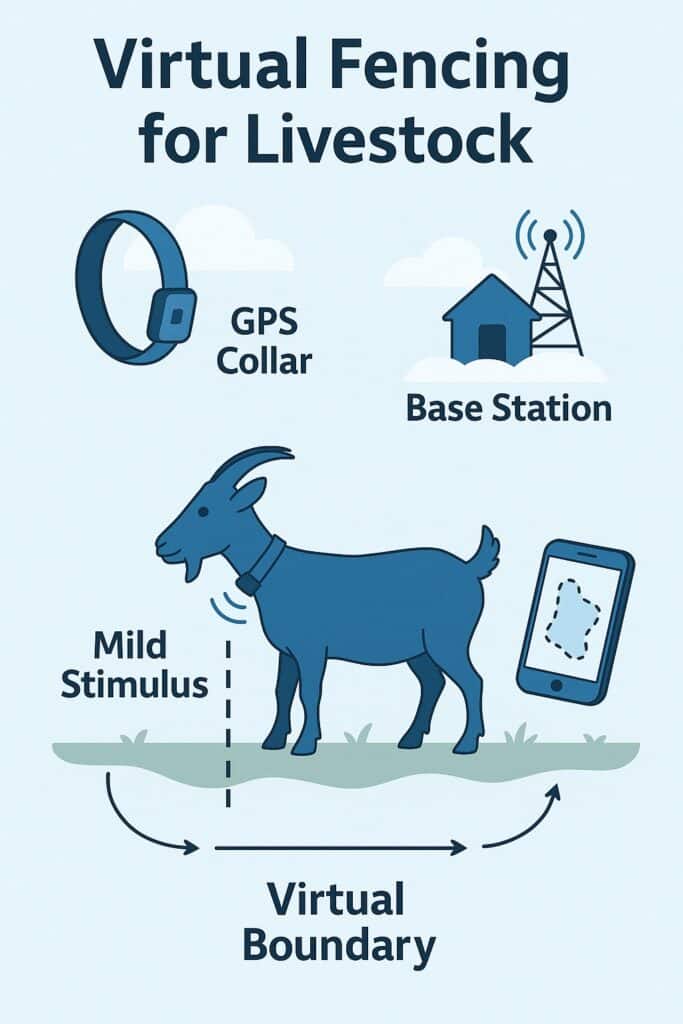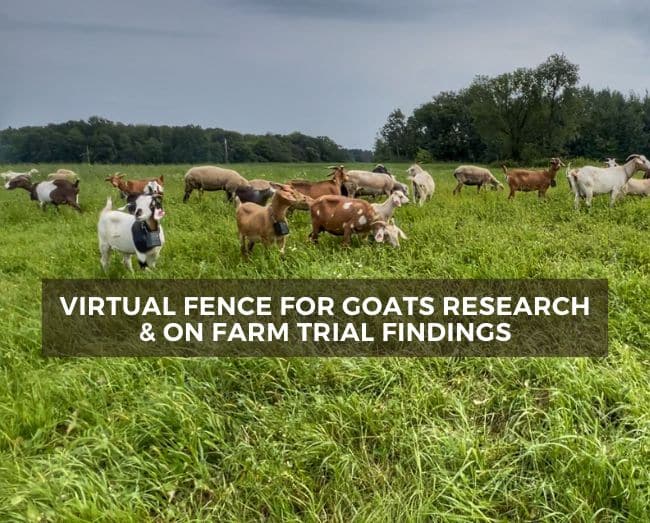Virtual fencing is no longer just a concept. It has been tested with goats in both research herds and commercial operations. If you are raising goats and considering this technology, here is what studies and producer field trials reveal about how goats respond, what works best, and what to watch for.
How goats learn the virtual fence system
Research shows that goats can quickly understand the audio and pulse signals used in virtual fencing.
- Rapid learning: Goats pick up the audio to pulse association quickly. Studies show the success ratio, responding to the audio cue without needing a pulse, improves steadily over several days. By days 4 to 5, naïve goats had nearly eliminated escape attempts. Naïve goats are defined as those who are slower to understand how the audio cues and stimulus works as compared to the rest of the herd.
- Generalization: Once trained, goats continued to respect the virtual fence line after moving to new pastures and paddocks, showing that the learning carries over.
- Boundary testing: Some goats “test” the line repeatedly, setting off many audio cues but few shocks. This is still a sign of learning, since the collar records their turn-backs before they cross.

Animal welfare and stress
Goat welfare has been evaluated in studies using both behavioral observations and stress hormone measurements.
- Stress indicators: Research measured faecal cortisol metabolites (a physiological stress marker). Virtual fence goats did not show elevated stress compared to controls. In fact, cortisol declined over time.
- Behavior: Goats did spend more time vigilant (standing and scanning). That may indicate caution near the boundary, but not heightened physiological stress.
- Practical takeaway: While goats show caution near virtual fence boundaries, studies suggest no negative long-term stress response.
Training protocols that work
Successful training requires a clear introduction period before goats are fully managed under virtual fencing.
- Start with visuals: For the first 1 to 2 days, add visual support (such as a physical fence: posts with a single electrified wire on day 1, then posts only on day 2). Remove visual supports after goats associate audio with a boundary.
- Human presence: When goats are first put out in a paddock with the virtual fence, have someone stand about 5 yards beyond the boundary. This should help prevent goats from initially charging through the “fence line.”
- Teach vs. operating mode:
- Teach mode: In the early stage of training, the collar is set so if a goat hears the audio cue and simply turns its head away from the boundary, the sound stops. The goat is “rewarded” by the removal of the sound, even if it does not physically step back. This helps the animal start to make the connection that the audio cue means “change direction.”
- Operating mode: After the goat has experienced a set number of audio cues without needing a pulse, the collar automatically shifts to operating mode. At this point, the goat must move its whole body away from the boundary for the audio to stop. A simple head turn is no longer enough. This reinforces the expectation that the goat should physically retreat, which is essential for safe and effective containment.
Collars and equipment details
The Nofence system has specific design features and operating settings that producers should know before use.
- Collar specs (Nofence goat/sheep collar):
- Audio cue: 2 to 4.2 kHz, 5 to 20 seconds
- Pulse: about 1.5 kV, 0.1 J, 0.5 s
- Weight: about 1 lb. with solar panels
- Shelter beacons: Block GPS indoors so goats are not cued in barns.
- Collar fit is very important. Too loose equals more shocks. Too tight equals strap wear or missed head-movement detection.
Containment and escapes
Studies and on-farm projects have compared escape incidents under virtual fencing and traditional electric netting.
- Controlled herds: Goats showed near-zero escapes after 4 to 5 days of training.
- On-farm trials: Out of 35 paddocks, only 1 incident with virtual fencing required action versus 4 incidents with electronet. App alerts and remote boundary edits made recovery quicker (SARE projects).
- Multi-species grazing: Co-grazing with cattle requires extra caution. One trial showed goats startled when heifers crowded the boundary, but adding a corral “home spot” reduced issues.
Labor and time savings
Farmers reported virtual fencing significantly reduced time spent on fence setup and troubleshooting.
- Fewer minutes per paddock: Virtual fencing reduced labor by about 147 minutes per paddock compared to electronet. That includes setup, battery swaps, and troubleshooting.
- Operational peace of mind: Real-time alerts and GPS tracking allowed farmers to respond quickly instead of guessing when netting failed.
Terrain and paddock design
Field studies with virtual fence, such as Nofence, looked at how landscape and fence layout affected performance.
- GPS variance: Expect about 16 feet of positional error. Always offset virtual fence lines from sensitive areas such as roads or water hazards.
- Paddock shape: Avoid narrow setups (less than 100 ft wide) or “canyons” between buildings during training. Broad, open boundaries are easier for goats to learn.
- Terrain: Research in varied landscapes (rolling hills, brushy paddocks) found no major performance differences.
Common pitfalls
Research and field use identified technical and management issues that can cause problems.
- Tech glitches: Some collars (around 15 percent) had hardware or battery issues. Goats quickly notice and may follow a collar that is not working, so check devices regularly.
- Youngstock: Kids under 4 months were not collared in most trials due to neck size and collar weight.
- Human and animal influence: Bottle-raised goats or other livestock interactions can disrupt training. Keep early sessions controlled.
Practical recommendations based on research and field trials
Based on research and farmer experience, here are the key steps for using virtual fencing with goats.
- Before starting to use virtual fence
- Fit collars properly. Skip kids under 4 months.
- Build a central corral “home spot” for handling and battery swaps.
- Plan boundary offsets for GPS error.
- Training (first 2 days):
- Use visual cues.
- Have a person discourage rushing at boundaries.
- Design paddocks with wide boundaries to start.
- Operations:
- Expect fewer labor hours and faster response to issues than with netting.
- Monitor vigilance but know that research on stress markers show virtual fencing is goat-appropriate.
How research was conducted
The information in this article comes from a mix of controlled research studies and on-farm producer trials. Research herds in Europe tested how goats respond to virtual fencing by measuring learning rates, stress levels, and behavior changes. These studies used physiological data, like faecal cortisol metabolites, along with detailed behavioral observations to evaluate welfare.
In the United States, farmer-led projects supported by SARE grants tested virtual fencing in commercial goat grazing operations. These trials focused on real-world factors such as time savings, containment success, GPS performance, and multi-species grazing challenges. Together, the research and field experience provide both scientific and practical insights into how virtual fencing works with goats.
References
- Wilms L. et al. 2025. Assessing learning, behaviour, and stress level in goats while testing a virtual fencing training protocol.
- Eftang S. et al. 2022. Goats are able to adapt to virtual fencing; A field study in commercial goat herds on Norwegian farms.
- SARE FNC21-1306 Final Report. Testing Virtual Fence Technology in an Upper Midwestern Goat Grazing Operation.
- SARE FNC24-1403 Progress Report. Multi-species grazing with virtual fencing in critical watersheds.

LEAVE A COMMENT
Comments